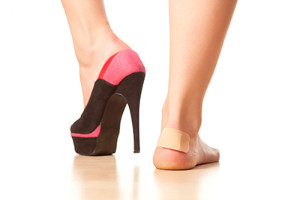What Causes Blisters on the Feet?
Monday, 09 April 2018 00:00 Blisters on the feet typically develop as a result of increased friction. A blister generally looks like a small area resembling a bubble and consists of fluid that protects the raw skin. It’s advised to not pop or drain the blister, as the blister can possibly prevent an infection from developing and can promote healing. A common reason friction on the feet can occur may be wearing shoes that fit poorly, causing the toes to rub on the inside of the shoe. Additional reasons may include wearing shoes without socks and walking for extended periods of time. If you experience blisters forming on the feet, it’s suggested to stop wearing the shoes that caused this condition to develop, and walk barefoot as often as possible. The majority of blisters will heal naturally, although complications such as wound infections may occur typically in patients who have diabetes or poor circulation. A consultation with a podiatrist is recommended if you are experiencing pain or if the blisters are not healing properly.
Blisters on the feet typically develop as a result of increased friction. A blister generally looks like a small area resembling a bubble and consists of fluid that protects the raw skin. It’s advised to not pop or drain the blister, as the blister can possibly prevent an infection from developing and can promote healing. A common reason friction on the feet can occur may be wearing shoes that fit poorly, causing the toes to rub on the inside of the shoe. Additional reasons may include wearing shoes without socks and walking for extended periods of time. If you experience blisters forming on the feet, it’s suggested to stop wearing the shoes that caused this condition to develop, and walk barefoot as often as possible. The majority of blisters will heal naturally, although complications such as wound infections may occur typically in patients who have diabetes or poor circulation. A consultation with a podiatrist is recommended if you are experiencing pain or if the blisters are not healing properly.
Blisters are prone to making everyday activities extremely uncomfortable. If your feet are hurting, contact Dr. John C. Lawlor of Florida. Our doctor can provide the care you need to keep you pain-free and on your feet.
Foot Blisters
Foot blisters develop as a result of constantly wearing tight or ill-fitting footwear. This happens due to the constant rubbing from the shoe, which can often lead to pain.
What Are Foot Blisters?
A foot blister is a small fluid-filled pocket that forms on the upper-most layer of the skin. Blisters are filled with clear fluid and can lead to blood drainage or pus if the area becomes infected.
How Do Blisters Form?
Blisters on the feet are often the result of constant friction of skin and material, usually by shoe rubbing. Walking in sandals, boots, or shoes that don’t fit properly for long periods of time can result in a blister. Having consistent foot moisture and humidity can easily lead to blister formation.
Prevention & Treatment
It is important to properly care for the affected area in order to prevent infection and ease the pain. Do not lance the blister and use a Band-Aid to provide pain relief. Also, be sure to keep your feet dry and wear proper fitting shoes. If you see blood or pus in a blister, seek assistance from a podiatrist.
If you have any questions, please feel free to contact one of our our offices located in Cape Coral and LaBelle, FL . We offer the newest diagnostic and treatment technologies for all your foot care needs.
Read more about Blisters on the Feet







